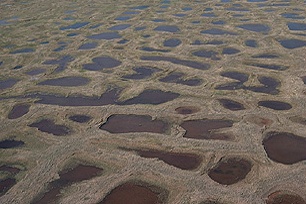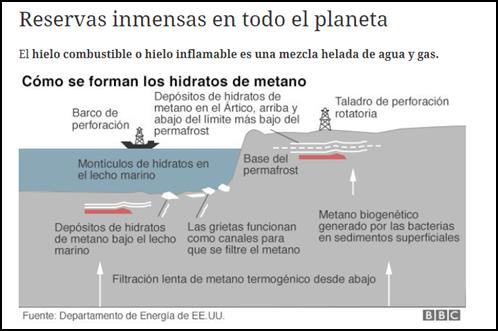So-called “flammable ice” extracted from the ocean floor may become a great source of energy in the future. According to researchers if extraction techniques are perfected, the deposits may guarantee 1,000 years of global energy consumption.
Although for many it is a new discovery, countries have been researching this material for decades. It combines molecules of water and natural gas and is found in deep ocean areas and also in different permafrost* areas like tundra.
China is one of the countries developing the technology to mine it. Last year its authorities announced a huge success: the first extraction made in waters close to the city of Hong Kong, at 1,266 meters deep. As different media outlets in the country reported, 8,350 cubic meters of this potential energy source were extracted per day over the course of eight days.
This extraction may represent a true energy revolution; Chinese authorities calculate that in China alone there may be flammable ice reserves equivalent to 80,000 tons of oil, which would be enough to power all the nation’s energy needs for practically two decades.
What is flammable ice?
It was discovered for the first time in the former Soviet Union in the 1960s. It is an energy source that looks like ice, its namesake, but when its temperature is raised or its pressure is lowered, it breaks down into water and natural gas. It is produced by excretions from bacteria that live in settings as difficult for supporting life as the abyssal zone or permafrost (permanently frozen ground). There are also different types of flammable ice. Chinese authorities, for example, are working with methane hydrate, one of the most plentiful types
It looks like ice, but when its pressure is lowered or its temperature is raised, it generates water and natural gas.
This structure is stable at very low temperatures and very high pressures. Under normal temperature and pressure conditions it decomposes, releasing methane, common natural gas and water. One cubic meter of flammable ice is equivalent to no less than 164 cubic meters of natural gas.
“It looks like ice crystals but if you zoom in to a molecular level, you see that the methane molecules are caged in by the water molecules,” Associate Professor Praveen Linga from the Department of Chemical and Biomolecular Engineering at the National University of Singapore told the BBC.

Image: Permafrost, a permanently frozen layer of ground that is not permanently covered in ice or snow, n very cold periglacial regions like tundra.
China and Japan, two countries with high energy consumption and scarce hydrocarbon reserves, have been the nations most interested in developing a potential commercial use for this energy source. Other leading countries in flammable ice exploration are India and South Korea, which also don’t have their own oil reserves. While the US and Canada are also active in the field, they have been focusing their explorations on methane hydrates under permafrost in the far north of Alaska and Canada.
A few disseting voices
However, the international community has many doubts and fears surrounding the potential environmental harm that this extraction could cause. The problem is that methane is highly explosive, so extraction may pose major risks. In this case the potential danger is that the methane will escape, because that could have grave consequences for global warming, as this gas has a much higher potential impact on climate change than carbon dioxide. However, China argues that energy generation from methane hydrate combustion produces 20% less polluting emissions than oil and 40% less than coal, the resource that continues to dominate that country’s energy industry.
The problem is that methane is highly explosive, so extraction may pose major risks
In an interview published by Agencia EFE, Lin Bo Quiang, Director of the China Center for Energy Economic Research at Xiamen University, ensured that flammable ice “is a rather clean energy source and is found in large quantities.” He also argued that “if China is able to exploit it, it will be very useful to us, although the trouble is developing the necessary technology.”
One cubic meter of this substance releases close to 160 cubic meters of gas. This means that it is a highly energy-intensive fuel.
The crux, though, is that extracting the gas is extremely difficult and energy consuming.
Reserves
 China believes that if extraction and energy-harnessing techniques are perfected, which could take between 10 and 30 years, there would be enough reserves to ensure 1,000 years of global energy consumption. There are large reserves under all the world’s oceans, especially on the edge of continental shelves, such as the large cache at the bottom of the Pacific Ocean stretching 5,000 miles between Central America and Hawaii.
China believes that if extraction and energy-harnessing techniques are perfected, which could take between 10 and 30 years, there would be enough reserves to ensure 1,000 years of global energy consumption. There are large reserves under all the world’s oceans, especially on the edge of continental shelves, such as the large cache at the bottom of the Pacific Ocean stretching 5,000 miles between Central America and Hawaii.





